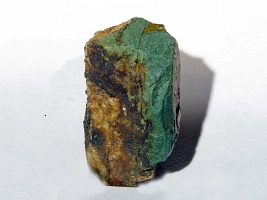
Locality: Hurricane Mtn., Conway, NH
Specimen Size: 2 cm specimen. Glauconite on microcline
Field Collected: Peter Samuelson - 1976
Catalog No.: A Gordon Jackson specimen
Notes: Glauconite is essentially the K-deficient equivalent of celadonite.
Mindat/org states "For practical purposes, if the mineral occurred in a sedimentary rock it was called 'glauconite' and if in a volcanic rock it was called 'celadonite'.“ [tm] This does not seem to be the case here.
Bishop et. al. in their 2008 article in Clay Minerals (3/ 2008) include an analysis of a Hurricane Mtn. glauconite with a formula:
Na0.03K0.753(Ti0.003Al0.202Fe3+1.426Fe2+0.402Mg0.004)(Si3.541Al0.549)O10(OH)2 .
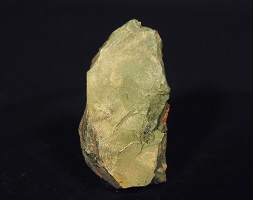
Locality: Hurricane Mtn., Conway, NH
Specimen Size: 3.5 cm specimen of massive, amorphous, Glauconite
Field Collected: Gordon Jackson
Catalog No.: 1681
Notes: In February, 2019, a polished grain EDS analysis on a sample from this specimen indicated a celadonite group mineral. Presently, magnesium is an "essential element" for glauconite, (per mindat.org). No magnesium was detected in my analysis.
A PXRD of Hurricane Mtn. glauconite was obtained from a sample submitted to John Attard's XRD service. This PXRD plot is a good match for glauconite.
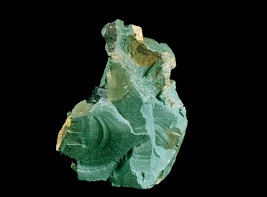
Locality: Hurricane Mtn., Conway, NH
Specimen Size: 3 cm specimen of massive, amorphous, Glauconite
Field Collected:
Catalog No.: A Harvard Museum specimen
Notes: A Kevin Czaja photo
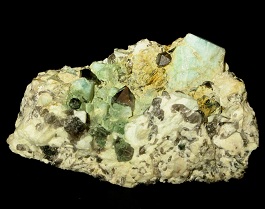
Locality: Government Pit, Albany, NH
Specimen Size: 7 cm specimen. Green Glauconite coating on Microcline and smoky quartz.
Field Collected: Tom Mortimer
Catalog No.: 1289
Notes: This specimen was previously believed to be an example of New Hampshire nontronite. The specimen has the appearance of what collectors have thought to be nontronite-chloropal. Nontronite (= chloropal) is reported in several references as occurring in the Conway area (e.g. Philip Morrill New Hampshire Mines and Mineral Localities). However, no confirmed/analyzed examples have been located. An EDS analysis showed this dusty, green, coating to be glauconite. Note: glauconite has potassium as an essential element, it is not present in nontronite.
Nontronite has been removed from my NH species list until a proven sample can be found.
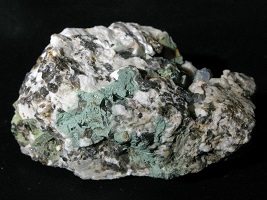
Locality: Government Pit, Albany, NH
Specimen Size: 5 cm specimen with soft blue-green mineral
Field Collected: Leroy Grant - 1970's
Catalog No.: 2094
Notes: A November 2018 carbon tape grain EDS analysis (BC302) gave a result for which glauconite was the "best fit."
Glauconite chemistry is: (K,Na)(Fe+3,Al,Mg)2((Si,Al)4O10)(OH)2 . The chemistry from this EDS analysis gave: K0.24Fe0.34Al2.35Si3O22.8 , normalized for 3 atoms of Si.
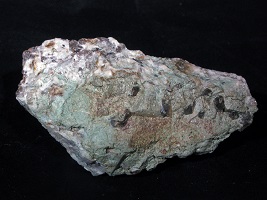
Locality: Government Pit, Albany, NH
Specimen Size: 5.5 cm specimen with soft, pale-green, glauconite on microcline and smoky quartz.
Field Collected: Leroy Grant - early 1970's
Catalog No.: 2108
Notes: A PXRD analysis of a sample from this specimen gave a mixed result. A moderately high PXRD score went to corrensite, a dark green, dull, waxy, earthy, magnesium dominant, sheet silicate. A quantitative EDS analysis, with light element detection for this government pit mineral is needed.
A Kerry Day qualitative EDS analysis of a similar Government Pit specimen (# 1289) indicated a K, Si, Fe, Al mineral. Glauconite chemistry is: (K,Na)(Fe+3,Al,Mg)2((Si,Al)4O10)(OH)2 .
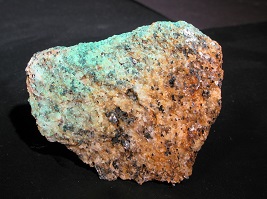
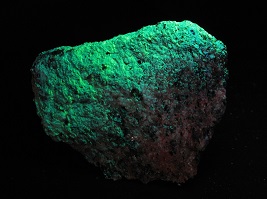
Locality: Construction Site, Rt. 101 - Nashua Rd., Bedford, NH
Specimen Size: 6 cm specimen with blue-green crust of glauconite on biotite granite. Daylight and SW UV images.
Field Collected: Tom Mortimer - Aug 2013
Catalog No.: 1855
Notes: My initial identification of this mineral was hyalite opal. Brightly colored opal var. hyalite is moderately uncommon in New England.
In late summer, 2013, I made this find from a small construction site in Bedford, NH. The blasted ledge area is less than one acre. The country rock is a coarse biotite gneiss. A mostly-buried narrow pegmatite extends along one side of the site for a distance of 30 to 50 feet. Occasional surface rocks near this pegmatite zone have an earthy mineral coating that varies from pale to bright green. My thought on first finding it was a copper carbonate or sulfate mineral. It is not soluble in water and no “fizz” was seen when muriatic acid was applied. A treatment with bleach in my ultrasonic cleaner did not remove the coating or alter its color (this is quite effective in exposing and removing organics). My surprise came with UV light….it fluoresced a bright green, not unlike autunite. However it lacks the luster and scaly-platy nature of autunite. Consulting several fellow collectors, it was suggested that the mineral coating is opal var. hyalite. Although I have collected hyalite opal from a number of New Hampshire localities, my specimens have always been of the milky, opalescent variety, or the white crusty variety. I have examined the coating under 40 x stereo magnification and am convinced that the coating is not paint, but a substance deposited from solution. A night-time collecting visit with a UV lamp turned up more specimens, a few that are classic, milky, opalescent, hyalite, ( see photo in Opal gallery). Reviewing hyalite opal photos on mindat, I see examples from Glastonbury, CT (http://www.mindat.org/photo-419463.html) that are similar to my find at Bedford.
All the specimens I found were right on the surface of freshly disturbed ground. Digging below the surface where the specimens were found yielded no blue-green crusted rocks. The fluorescent blue-green coating was found equally on fresh broken gneiss rocks AND obvious glacier origin pebbles. The coating is only seen on the surface side of specimens when collected, never on the dirt-side-down. The green crust is not seen in the interior of specimens with the crust on the exterior.
So the questions that come to mind are:
Can hyalite opal deposit quickly at surface conditions? (I estimate the elapsed time from tree covered lot to dirt and boulder construction site to be no longer than six weeks. There have been several periods of rain in that time. This site is still in the leveling and pre-build phase. No signs of any seeding, landscaping, or even erosion control hay bales when my specimens were collected.. Additional fact: the uranium level in the immediate area water wells is quite high – uranium is a possible UV activator.)
Canadian mineral collector Reiner Mielke informed me that “Uranyl ions can cause … silica to fluoresce strongly green. It doesn't take much uranyl ion to cause this and silica crusts can form overnight from silica saturated water at surface.”
A grain of this green crust was submitted to qualitative EDS analysis in the fall of 2013.
The EDS analysis showed Fe, K, Al, Si were present with a minor amount of barium. The "best fit" appeared to be glauconite, (compare EDS analysis of Government Pit specimen above). The fluorescence may be due to the presence of barium, which can be a fluorescence activator.
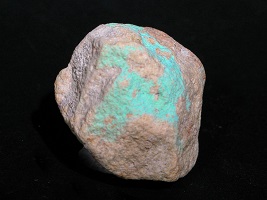
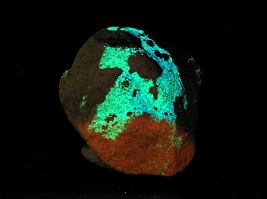
Locality: Construction Site, Rt. 101 - Nashua Rd., Bedford, NH
Specimen Size: 2.5 cm quartz pebble with blue-green glauconite crust. Daylight and SW UV images.
Field Collected: Tom Mortimer - Aug 2013
Catalog No.: 1854
Notes:
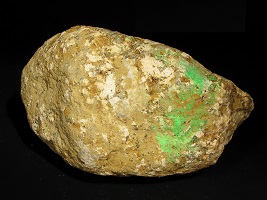
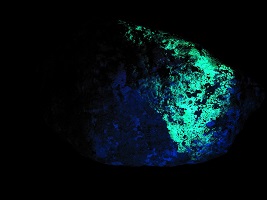
Locality: Construction Site, Rt. 101 - Nashua Rd., Bedford, NH
Specimen Size: 14 cm (5.5 inch) glacial worn granite rock with blue-green glauconite crust. Daylight and SW UV images.
Field Collected: Tom Mortimer - Aug 2013
Catalog No.:
Notes: